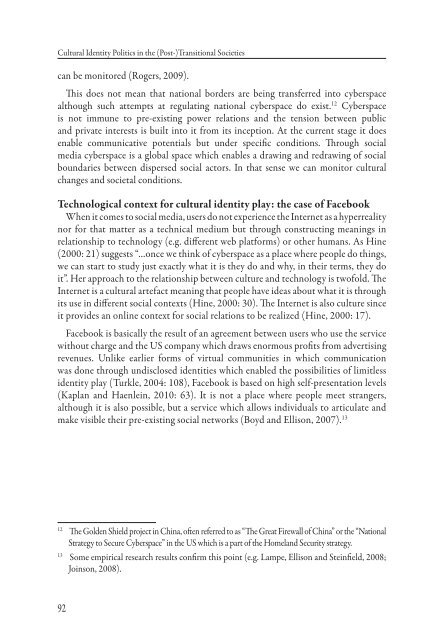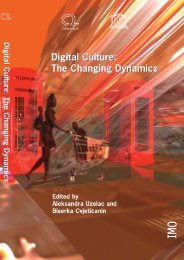free download in pdf format - Culturelink Network
free download in pdf format - Culturelink Network
free download in pdf format - Culturelink Network
You also want an ePaper? Increase the reach of your titles
YUMPU automatically turns print PDFs into web optimized ePapers that Google loves.
Cultural Identity Politics <strong>in</strong> the (Post-)Transitional Societies<br />
can be monitored (Rogers, 2009).<br />
Th is does not mean that national borders are be<strong>in</strong>g transferred <strong>in</strong>to cyberspace<br />
although such attempts at regulat<strong>in</strong>g national cyberspace do exist. 12 Cyberspace<br />
is not immune to pre-exist<strong>in</strong>g power relations and the tension between public<br />
and private <strong>in</strong>terests is built <strong>in</strong>to it from its <strong>in</strong>ception. At the current stage it does<br />
enable communicative potentials but under specifi c conditions. Th rough social<br />
media cyberspace is a global space which enables a draw<strong>in</strong>g and redraw<strong>in</strong>g of social<br />
boundaries between dispersed social actors. In that sense we can monitor cultural<br />
changes and societal conditions.<br />
Technological context for cultural identity play: the case of Facebook<br />
When it comes to social media, users do not experience the Internet as a hyperreality<br />
nor for that matter as a technical medium but through construct<strong>in</strong>g mean<strong>in</strong>gs <strong>in</strong><br />
relationship to technology (e.g. diff erent web platforms) or other humans. As H<strong>in</strong>e<br />
(2000: 21) suggests “…once we th<strong>in</strong>k of cyberspace as a place where people do th<strong>in</strong>gs,<br />
we can start to study just exactly what it is they do and why, <strong>in</strong> their terms, they do<br />
it”. Her approach to the relationship between culture and technology is twofold. Th e<br />
Internet is a cultural artefact mean<strong>in</strong>g that people have ideas about what it is through<br />
its use <strong>in</strong> diff erent social contexts (H<strong>in</strong>e, 2000: 30). Th e Internet is also culture s<strong>in</strong>ce<br />
it provides an onl<strong>in</strong>e context for social relations to be realized (H<strong>in</strong>e, 2000: 17).<br />
Facebook is basically the result of an agreement between users who use the service<br />
without charge and the US company which draws enormous profi ts from advertis<strong>in</strong>g<br />
revenues. Unlike earlier forms of virtual communities <strong>in</strong> which communication<br />
was done through undisclosed identities which enabled the possibilities of limitless<br />
identity play (Turkle, 2004: 108), Facebook is based on high self-presentation levels<br />
(Kaplan and Haenle<strong>in</strong>, 2010: 63). It is not a place where people meet strangers,<br />
although it is also possible, but a service which allows <strong>in</strong>dividuals to articulate and<br />
make visible their pre-exist<strong>in</strong>g social networks (Boyd and Ellison, 2007). 13<br />
12 Th e Golden Shield project <strong>in</strong> Ch<strong>in</strong>a, oft en referred to as “Th e Great Firewall of Ch<strong>in</strong>a” or the “National<br />
Strategy to Secure Cyberspace” <strong>in</strong> the US which is a part of the Homeland Security strategy.<br />
13 Some empirical research results confi rm this po<strong>in</strong>t (e.g. Lampe, Ellison and Ste<strong>in</strong>fi eld, 2008;<br />
Jo<strong>in</strong>son, 2008).<br />
92



